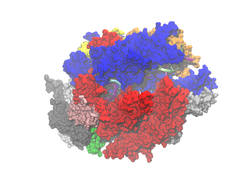RNA polymerases
| RNA polymerases | ||
|---|---|---|

|
||
| Surface model of the RNA polymerase II complex of baker's yeast (each of the 10 subunits colored differently), according to PDB 3G1G; RNA (left) and DNA (left + right) as a cartoon | ||
| Enzyme Classifications | ||
| EC, category | 2.7.7.6 , nucleotidyl transferase | |
| Substrate | Nucleoside triphosphate + RNA n | |
| Products | Diphosphate + RNA n + 1 | |
| EC, category | 2.7.7.48 , nucleotidyl transferase | |
| Response type | Addition of a ribonucleic acid | |
| Substrate | Nucleoside triphosphate + RNA n | |
| Products | Diphosphate + RNA n + 1 | |
RNA polymerases are enzymes that, as polymerases, catalyze the synthesis of ribonucleic acids (RNA) from ribonucleotides . They play an important role in the transcription of DNA .
Various RNA polymerases
In bacteria there is a DNA-dependent RNA polymerase that is involved in the expression of all genes. The prokaryotic RNA polymerase consists of the subunits α, β, β 'and the σ factor, whereby the α subunit is present twice and the others once each. The α 2 dimer is necessary for the assembly of the other subunits and binds regulatory proteins, the β subunit binds the nucleoside 5'-triphosphate and catalyzes the formation of the phosphodiester bond, the β 'subunit has a DNA-binding function. The σ-factor finally recognizes and binds to the promoter . Other σ factors are used under stress conditions; these can bind to the special promoters of special genes. In Escherichia coli, for example, the heat shock gene promoter is not recognized by the normal RNA polymerase with the σ70 subunit, but by a σ32 RNA polymerase, which is active in the event of a heat shock.
For the synthesis of the RNA primers for replication, bacteria have an additional DNA-dependent RNA polymerase, the primase DnaG.
There are four forms of RNA polymerase in eukaryotes :
- the RNA polymerase I , the formation of rRNA than pre-rRNA (45S to 18S is processed; 5.8S, 28S) in the nucleolus catalyzes
- the RNA polymerase II , the formation of the pre- mRNA , snoRNAs (small nucleolar RNAs) and some snRNAs (small nuclear RNA) as well as siRNA and miRNA catalyzes
- the RNA polymerase III , the formation of tRNA , rRNA 5S, 7SL RNA catalyzes some snRNAs and other small RNAs and
- RNA polymerase IV, which is responsible for the formation of siRNA.
The RNA polymerase II and III are inhibited by α- Amanitin .
In addition, there are RNA-dependent RNA polymerases that help in the reproduction of the genome of RNA viruses .
An example of an independent RNA polymerase is poly (A) polymerase , which is responsible for polyadenylation of the mRNA.
Biochemical aspects
RNA polymerases have a simple mechanism for error detection: if an unsuitable RNA nucleotide attaches to a base in the DNA , the RNA polymerase remains longer at the corresponding DNA site. This increases the likelihood that the poorly paired ribonucleotide will move away from the DNA again. Overall, this mechanism achieves an accuracy of one error per 10,000 base pairings. This corresponds approximately to one error per synthesized RNA molecule.
The RNA synthesis takes place in the 5 '→ 3' direction. The 3 'end of the complementary DNA strand segment thus corresponds to the 5' end of the mRNA and then the N-terminal end of the protein produced during translation ( colinearity ). The same applies to the 3 'end and the C-terminus. Thus, the RNA is built up along the complementary DNA sequence from 3 'to 5' as a template, but synthesized in 5´ → 3´, as is then read as mRNA from the ribosome in 5´ → 3´ direction and translated into the protein ( N-terminal → C-terminal).
In contrast to DNA polymerases, RNA polymerases do not require any free 3'-OH and thus no primer .
The RNA polymerases have a complex structure. Ten different polypeptide chains with a molecular mass between 7,700 and 140,000 Daltons , magnesium , zinc and two DNA chains are involved in yeast . In total, this RNA polymerase consists of over 28,000 atoms.
In E. coli , the RNA strand is elongated by the RNA polymerase at a rate of approx. 50 nucleotides per second (17 nm / s).
The American chemist Roger D. Kornberg received the 2006 Nobel Prize in Chemistry for elucidating the mechanism of transcription by means of RNA polymerase .
Individual evidence
- ↑ Stefan Ilic, Shira Cohen, Meenakshi Singh, Benjamin Tam, Adi Dayan: DnaG Primase — A Target for the Development of Novel Antibacterial Agents . In: Antibiotics . tape 7 , no. 3 , August 13, 2018, ISSN 2079-6382 , doi : 10.3390 / antibiotics7030072 , PMID 30104489 , PMC 6163395 (free full text).
- ↑ Alberts, et al. Fifth Edition P. 340
- ↑ E. Brändle, K. Zetsche: On the localization of the α-Amanitin-sensitive RNA polymerase in the cell nuclei of Acetabularia . In: Planta . tape 111 , no. 3 , September 1, 1973, ISSN 1432-2048 , pp. 209-217 , doi : 10.1007 / BF00385105 .